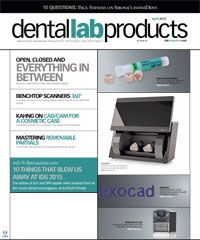How to understand and handle today's digital workflow
As technicians, we all want to be comfortable with the workflow to process cases through the lab. Most technicians are most comfortable with what they have been doing for years. They may bring CAD/CAM into the process here and there, but they haven’t fully given in to the digital revolution. Yet, with a greater understanding of today’s machines and software, the dental lab can improve on this, providing more precise restorations while still improving turnaround time.
As technicians, we all want to be comfortable with the workflow to process cases through the lab. Most technicians are most comfortable with what they have been doing for years. They may bring CAD/CAM into the process here and there, but they haven’t fully given in to the digital revolution. Yet, with a greater understanding of today’s machines and software, the dental lab can improve on this, providing more precise restorations while still improving turnaround time.
Digital dentistry continues to make dramatic inroads within the dental operatory. With several intraoral scanners already gaining new dentists daily and more scanners recently announced at Chicago Midwinter and IDS in Cologne, labs need to be ready to accept these types of cases. Currently, there is no one digital dental lab workflow. Labs have to make choices on what they can handle between locked and open clinical scanners. The trouble with that is there is no one correct solution. Labs are often kept out of the loop as their doctors decide to make the leap to digital. This ends up leaving the lab scrambling for answers while the clock is ticking on a case. The key is to take a proactive approach to the digital question.
Let’s start by being honest with ourselves: The typical laboratory alone cannot be all things to all people with digital dentistry. It’s prohibitively expensive to have the lab equipped to handle any and all types of digital cases coming in every day. Labs should make that decision themselves upfront, considering key factors such as volumes expected by technology, the return on investment on those volumes and which ones they want be prepared for, and then find partners to handle the cases they can’t or don’t want to handle internally. These partners can also open up new business for a lab by connecting to a network previously not available.
Related reading: 5 things every lab needs to know about outsourcing
So what are the key factors in choosing these “digital partners?”
1. The best partner to pair with is capable of handling any quality of scan data.
Not all STL files are created equal; each scanner’s files are unique. Core3dcentres has software to make otherwise unusable files clean and usable. The reason some manufacturers choose to use proprietary file types is the meta data that can be associated with a file. This could be margin lines, implant positioning or restoration type to name a few. The question becomes, do I need this extra information and what do I want to do with this file?
Read this: How to handle digital files from your dentist
2. The ability to create a monolithic restoration without a model is not only here but in daily use.
Yet when a model is desired for these or other types of restoration, digital dentistry makes these models incredibly accurate. The manufacturing of these models has additional labor and hardware/software considerations that you may wish your partner to handle. Can your partner help you create these models for your clinicians? Scan data STL files have no thickness. Additional design software is required to add thickness and preparation sectioning.
3. An implant case has additional considerations.
Will the model have a replica of the designed abutment or will it be created with a socket for a lab analog? An intraoral scan with an approved scan body from an implant library with the dimensions of a lab analog has the most accurate and streamlined workflow. Can your partner supply it?
Let’s expand on that question: Do we need a model to fabricate the restoration? With the accuracy of digital technology, my answer to that is usually no. Of course, the type of restoration is a big part of that answer. For monolithic restorations, even those with a cutback, modeless lab work has been done for years. With experience and training, digital restorations can be designed for more accurate and better fitting.
Must read: How to improve your implant work using a digital workflow
When I talk to technicians now, we discuss microns of differences between scanners or machines. Prior to digital, there was no accurate way to measure differences from one case to another (but we would not have been discussing microns for sure). The inherent differences, particularly expansion and contraction from impression materials, stones and investments, left the fit of a case up to the feel of the technician. Digital technology puts a quantitative value to this feel. It also gives the technicians views of cases that were never possible before. To be able to measure the distance to the opposing within the central groove area of posterior teeth is a great example of this.
Digital workflow has evolved over the past few years. As more elements of the dental field become digital we can expect a higher quality of restoration in a shorter amount of time. Our goal is always to provide the highest quality restoration for the patient. As we keep more accurate records of how we restore cases, we can learn to provide the highest level of care.
